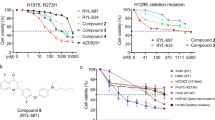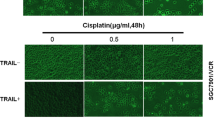Abstract
Human non-small-cell-lung-cancer (NSCLC) cells of p 53-null genotype were exposed to low-dosage topoisomearse II inhibitor etoposide (VP-16). The cellular proliferation rate could be effectively inhibited by VP-16 in dose-dependent manner. The effective drug concentration for growth inhibition could be as low as 0.5 μ M and the apoptotic phenotype became evident 48 h later. In H1299 cells, VP-16-induced cytotoxic effect was demonstrated associated with apoptosis that disappeared when restored with wild-type p53. Cell cycle analysis revealed that, upon VP-16 induction, cell death began with growth arrest by accumulating cells at the G2-M phase. The cells at sub-G1 phase increased at the expense of those at G2-M transition state. To assess the regulation of cell cycle modulators, western blot analysis of H1299 cell lysates showed the release of apoptosis initiator, cytochrome c and apaf-1 hours following drug induction. The cleavage of downstream effectors, procaspase-9 and procaspase-7, but not procaspase-3, was accompanied with proteolysis of poly-(ADP-ribose) polymerase (PARP). VP-16-activated procaspase-7 cleavage was abrogated in cells with ectopically expressed p53.On the other hand, the inhibited procaspase-7 fragmentation by caspase-specific inhibitor reversed apoptotic phenotype caused by drug induction. Thus, VP-16-induced apoptotic cell death was contributed by caspase-7 activation in p 53-deficient human NSCLC cells.
Similar content being viewed by others
References
Chen AY, Liu LF. DNA topoisomerases: Essential enzymes and lethal targets. Annu Rev Pharmacol Toxicol 1994; 34: 191–218.
Berger JM, Gamblin SJ, Harrison SC, et al. Structure and mechanism of DNA topoisomerase II. Nature 1996; 379: 225–232.
Froelich-Ammon SJ, Osheroff N. Topoisomerase poisons: Harnessing the dark side of enzyme mechanism. J Biol Chem 1995; 270: 21429–21432.
Dubrez L, Goldwasser F, Genne P, et al. The role of cell cycle regulation and apoptosis triggering in determining the sensitivity of leukemic cells to topoisomerase I and II inhibitors. Leukemia 1995; 9: 1013–1024.
Lee YJ, Shacter E. Oxidative stress inhibits apoptosis in human lymphoma cells. J Biol Chem 1999; 274: 19792–19798.
Soues S, Wiltshire M, Smith PJ. Differential sensitivity to etoposide (VP-16)-induced S phase delay in a panel of small-cell lung carcinoma cell lines with G1/S phase checkpoint dysfunction. Cancer Chemother Pharmacol 2001; 47: 133–140.
Hande KR. Etoposide: Four decades of development of a topoisomerase II inhibitor. Eur J Cancer 1998; 34: 1514–1521.
Wu GS, El-Diery WS. p53 and chemosensitivity. Nat Med 1996; 2: 255–256.
Lai SL, Perng RP, Hwang J. p53 gene status modulates the chemosensitivity of non-small cell lung cancer cells. J Biomed Sci 2000; 7: 64–70.
McNeish IA, Bell SJ, Lemoine NR. Gene therapy progress and prospects: Cancer gene therapy using tumour suppressor genes. Gene Ther 2004; 11: 497–503.
Takahashi T, Nau MM, Chiba I, et al. p53: A frequent target for genetic abnormalities in lung cancer. Science 1989; 246: 491–494.
Rosl F. A simple and rapid method for detection of apoptosis in human cells. Nucleic Acids Res 1992; 20: 5243.
Budihardjo I, Oliver H, Lutter M. et al. Biochemical pathways of caspase activation during apoptosis. Annu Rev Cell Dev Biol 1999; 15: 269–290.
Schreiber V, Hunting D, Trucco C. et al. A dominant-negative mutant of human poly(ADP-ribose) polymerase affects cell recovery, apoptosis, and sister chromatid exchange following DNA damage. Proc Natl Acad Sci U S A 1995; 92: 4753– 4757.
Wang Y, Blandino G, Givol D. Induced p21waf expression in H1299 cell line promotes cell senescence and protects against cytotoxic effect of radiation and doxorubicin. Oncogene 1999; 18: 2643–2649.
Slee EA, Harte MT, Kluck RM, et al. Ordering the cytochrome c-initiated caspase cascade: Hierarchical activation of caspases-2, -3, -6, -7, -8, and -10 in a caspase-9-dependent manner. J Cell Biol. 1999; 144: 281–292.
Houghton JA. Apoptosis and drug response. Curr Opin Oncol 1999; 11: 475–481.
Hickman JA. Apoptosis induced by anticancer drugs. Cancer Metastasis Rev 1992; 11: 121–139.
Hartwell LH, Kastan MB. Cell cycle control and cancer. Science 1994; 266: 1821–1828.
Thompson CB. Apoptosis in the pathogenesis and treatment of disease. Science 1995; 267: 1456–1462.
Weinert T. A DNA damage checkpoint meets the cell cycle engine. Science 1997; 277: 1450–1451.
Darzynkiewicz Z, Li X, Gong J. Assays of cell viability: Discrimination of cells dying by apoptosis. Methods Cell Biol 1994; 41: 15–38.
Wyllie AH, Kerr JF, Currie AR. Cell death: The significance of apoptosis. Int Rev Cytol 1980; 68: 251–306.
Cayrol C, Knibiehler M, Ducommun B. p21 binding to PCNA causes G1 and G2 cell cycle arrest in p53-deficient cells. Oncogene 1998; 16: 311–320.
Niculescu AB, 3rd Chen X, Smeets M, et al. Effects of p21(Cip1/Waf1) at both the G1/S and the G2/M cell cycle transitions: pRb is a critical determinant in blocking DNA replication and in preventing endoreduplication. Mol Cell Biol 1998; 18: 629–643.
Dulic V, Stein GH, Far DF, et al. Nuclear accumulation of p21Cip1 at the onset of mitosis: A role at the G2/M-phase transition. Mol Cell Biol 1998; 18: 546–557.
Han Z, Wei W, Dunaway S, et al. Role of p21 in apoptosis and senescence of human colon cancer cells treated with camptothecin. J Biol Chem 2002; 277: 17154–17160.
Roninson IB. Tumor cell senescence in cancer treatment. Cancer Res 2003; 63: 2705–2715.
Sugrue MM, Shin DY, Lee SW, et al. Wild-type p53 triggers a rapid senescence program in human tumor cells lacking functional p53. Proc Natl Acad Sci U S A 1997; 94: 9648–9653.
Bhatia K, Pommier Y, Giri C, et al. Expression of the poly(ADP-ribose) polymerase gene following natural and induced DNA strand breakage and effect of hyperexpression on DNA repair. Carcinogenesis 1990; 11: 123–128.
Bursztajn S, Feng JJ, Berman SA, et al. Poly (ADP-ribose) polymerase induction is an early signal of apoptosis in human neuroblastoma. Brain Res Mol Brain Res 2000; 76: 363–376.
Slee EA, Adrain C, Martin SJ. Executioner caspase-3, -6, and -7 perform distinct, non-redundant roles during the demolition phase of apoptosis. J Biol Chem 2001; 276: 7320–7326.
Mesner PW, Jr, Budihardjo II, Kaufmann SH. Chemotherapy-induced apoptosis. Adv Pharmacol 1997; 41: 461–499.
Reed JC. Mechanisms of apoptosis. Am J Pathol 2000; 157: 1415–1430.
Zheng TS, Hunot S, Kuida K, et al. Deficiency in caspase-9 or caspase-3 induces compensatory caspase activation. Nat Med 2000; 6: 1241–1247.
Perkins CL, Fang G, Kim CN, et al. The role of Apaf-1, caspase-9, and bid proteins in etoposide- or paclitaxel-induced mitochondrial events during apoptosis. Cancer Res 2000; 60: 1645–1653.
Janicke RU, Engels IH, Dunkern T, et al. Ionizing radiation but not anticancer drugs causes cell cycle arrest and failure to activate the mitochondrial death pathway in MCF-7 breast carcinoma cells. Oncogene 2001; 20: 5043–5053.
Marcelli M, Cunningham GR, Walkup M, et al. Signaling pathway activated during apoptosis of the prostate cancer cell line LNCaP: Overexpression of caspase-7 as a new gene therapy strategy for prostate cancer. Cancer Res 1999; 59: 382–390.
Mc Gee MM, Hyland E, Campiani G, et al. Caspase-3 is not essential for DNA fragmentation in MCF-7 cells during apoptosis induced by the pyrrolo-1,5-benzoxazepine, PBOX-6. FEBS Lett 2002; 515: 66–70.
Germain M, Affar EB, D’Amours D, et al. Cleavage of automodified poly(ADP–ribose) polymerase during apoptosis. Evidence for involvement of caspase-7. J Biol Chem 1999; 274: 28379–28384.
Essmann F, Engels IH, Totzke G, et al. Apoptosis resistance of MCF-7 breast carcinoma cells to ionizing radiation is independent of p53 and cell cycle control but caused by the lack of caspase-3 and a caffeine-inhibitable event. Cancer Res 2004; 64: 7065–7072.
Author information
Authors and Affiliations
Corresponding author
Rights and permissions
About this article
Cite this article
Chiu, CC., Lin, CH.M.Y. & Fang, K. Etoposide (VP-16) sensitizes p53-deficient human non-small cell lung cancer cells to caspase-7-mediated apoptosis. Apoptosis 10, 643–650 (2005). https://doi.org/10.1007/s10495-005-1898-8
Issue Date:
DOI: https://doi.org/10.1007/s10495-005-1898-8




